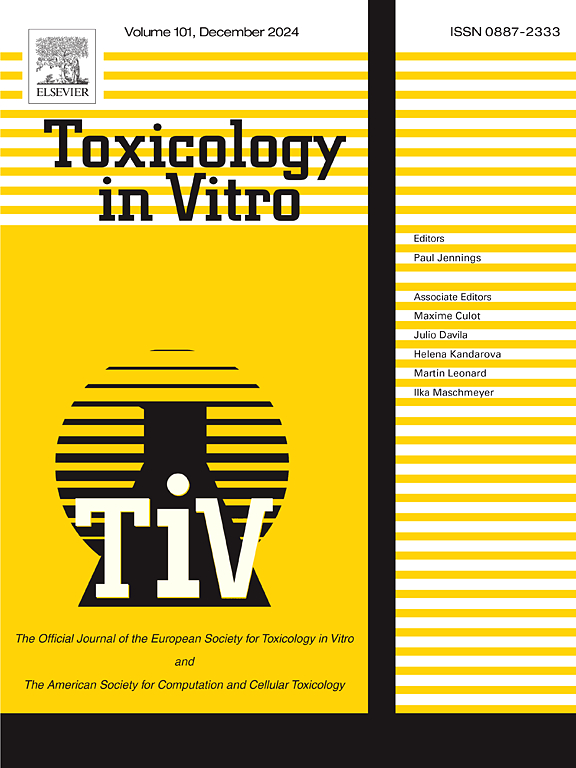环境相关浓度的锑对人类健康构成潜在风险:对人体脐静脉内皮细胞的评估
IF 2.6
3区 医学
Q3 TOXICOLOGY
引用次数: 0
摘要
锑矿开采和含锑药物的使用构成了已知的健康风险。本研究考察了环境相关浓度Sb (0.12-12 mg L−1)对人脐静脉内皮细胞(HUVECs)的毒性。Sb对HUVECs 50%致死浓度(LC50)为11.4 mg L−1。暴露于高水平Sb通过改变细胞周期调节因子的表达,抑制G0/G1向S和S向G2/M的转变,诱导细胞周期阻滞。在1.2 mg L−1 Sb下,CKD6和p21在HUVECs中的表达分别是无Sb对照组的0.75倍和1.32倍(p <;0.01)。在12 mg L−1 Sb下,CDK2、CKD6和p27的表达分别下降了1.54倍、4.41倍和1.54倍(p <;0.001),而p21表达增加了3.03倍(p <;0.001)。Annexin V-FITC/PI染色和Bax表达变化(1.21-1.30倍,p <;0.01)和Bcl-2(0.65 ~ 0.83倍)。氧化损伤是驱动细胞凋亡的关键因素,可能通过下调抗氧化基因(CAT、GPX1、GSTP1)和上调应激反应基因(HO-1、SOD1、TrxR1)实现。线粒体中产生的H2O2升高可能是由于H2O2代谢失衡导致细胞凋亡。这些发现表明,环境相关浓度的Sb可以对HUVECs产生细胞毒性,这应该是人类心血管疾病的潜在关注。本文章由计算机程序翻译,如有差异,请以英文原文为准。

Environmentally relevant concentrations of antimony pose potential risks to human health: An evaluation on human umbilical vein endothelial cells
Antimony (Sb) ore exploitation and the use of Sb-containing drugs pose known health risks. This study investigated the toxicity of environmentally relevant concentrations of Sb (0.12–12 mg L−1) on human umbilical vein endothelial cells (HUVECs). The 50 % lethal concentration (LC50) of Sb to HUVECs was 11.4 mg L−1. Exposing to high level of Sb induced cell cycle arrest by altering the expression of cell cycle regulators, inhibiting the transitions of G0/G1 to S and S to G2/M. At 1.2 mg L−1 Sb, CKD6 and p21 expressions in HUVECs changed to 0.75 and 1.32 folds that of no-Sb control, respectively (p < 0.01). At 12 mg L−1 Sb, CDK2, CKD6, and p27 expressions decreased by 1.54, 4.41, and 1.54 folds (p < 0.001), while p21 expression increased by 3.03 folds (p < 0.001) as compared to control. Sb also led to cell apoptosis, evidenced by Annexin V-FITC/PI staining and changes in the expressions of Bax (1.21–1.30 folds, p < 0.01) and Bcl-2 (0.65–0.83 folds). Oxidative damage was a pivotal factor driving cell apoptosis, probably through down-regulating antioxidant genes (CAT, GPX1, and GSTP1) and up-regulating stress response genes (HO-1, SOD1, and TrxR1). The elevated H2O2 generated in mitochondria likely contributed to cell apoptosis due to the imbalance in H2O2 metabolism. These findings suggest that environmentally relevant concentrations of Sb can exert cytotoxicity to HUVECs, which should be of potential concern for human cardiovascular disease.
求助全文
通过发布文献求助,成功后即可免费获取论文全文。
去求助
来源期刊

Toxicology in Vitro
医学-毒理学
CiteScore
6.50
自引率
3.10%
发文量
181
审稿时长
65 days
期刊介绍:
Toxicology in Vitro publishes original research papers and reviews on the application and use of in vitro systems for assessing or predicting the toxic effects of chemicals and elucidating their mechanisms of action. These in vitro techniques include utilizing cell or tissue cultures, isolated cells, tissue slices, subcellular fractions, transgenic cell cultures, and cells from transgenic organisms, as well as in silico modelling. The Journal will focus on investigations that involve the development and validation of new in vitro methods, e.g. for prediction of toxic effects based on traditional and in silico modelling; on the use of methods in high-throughput toxicology and pharmacology; elucidation of mechanisms of toxic action; the application of genomics, transcriptomics and proteomics in toxicology, as well as on comparative studies that characterise the relationship between in vitro and in vivo findings. The Journal strongly encourages the submission of manuscripts that focus on the development of in vitro methods, their practical applications and regulatory use (e.g. in the areas of food components cosmetics, pharmaceuticals, pesticides, and industrial chemicals). Toxicology in Vitro discourages papers that record reporting on toxicological effects from materials, such as plant extracts or herbal medicines, that have not been chemically characterized.
 求助内容:
求助内容: 应助结果提醒方式:
应助结果提醒方式:


